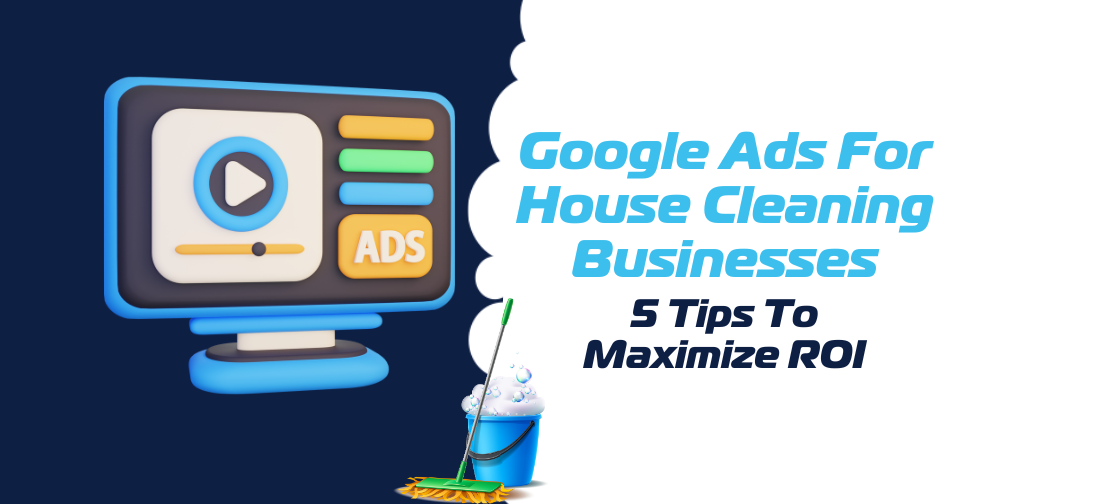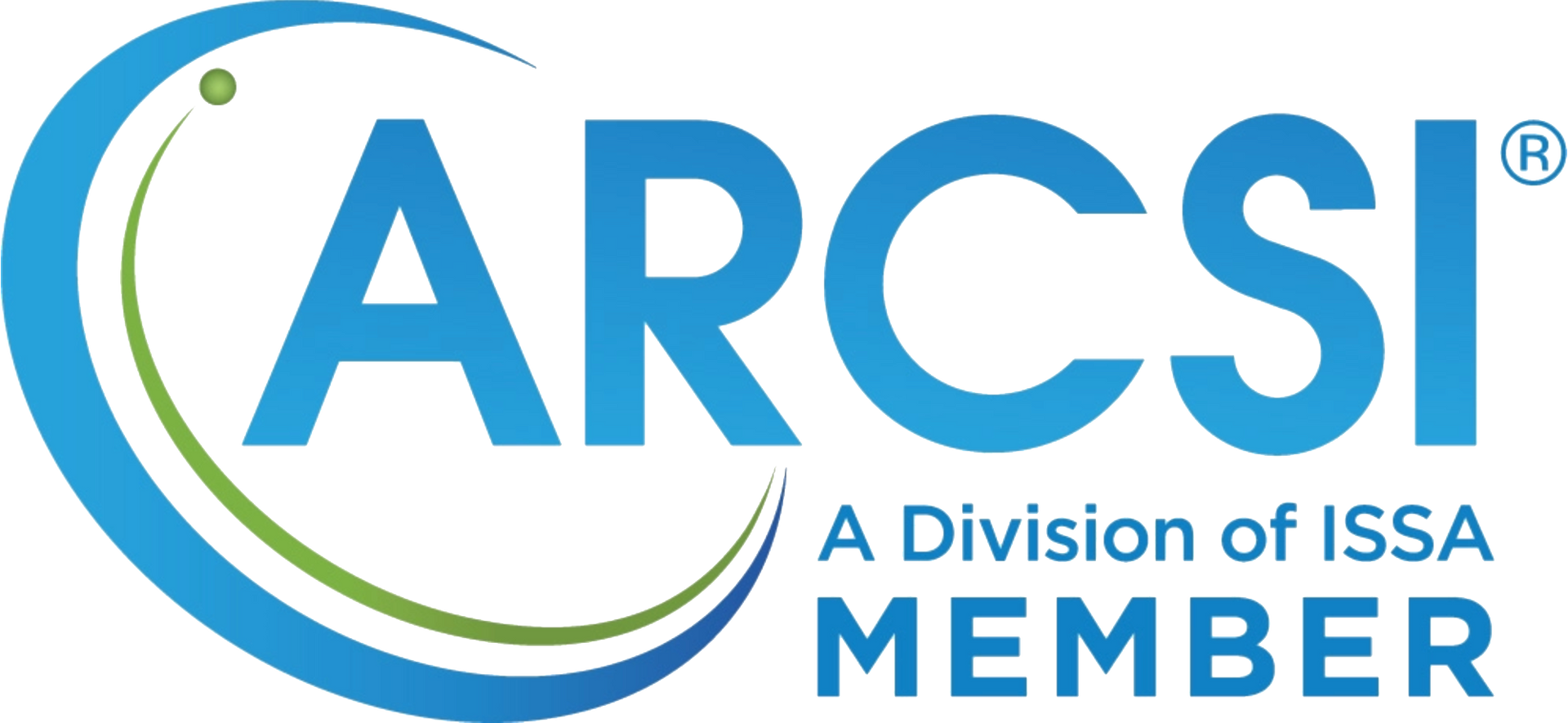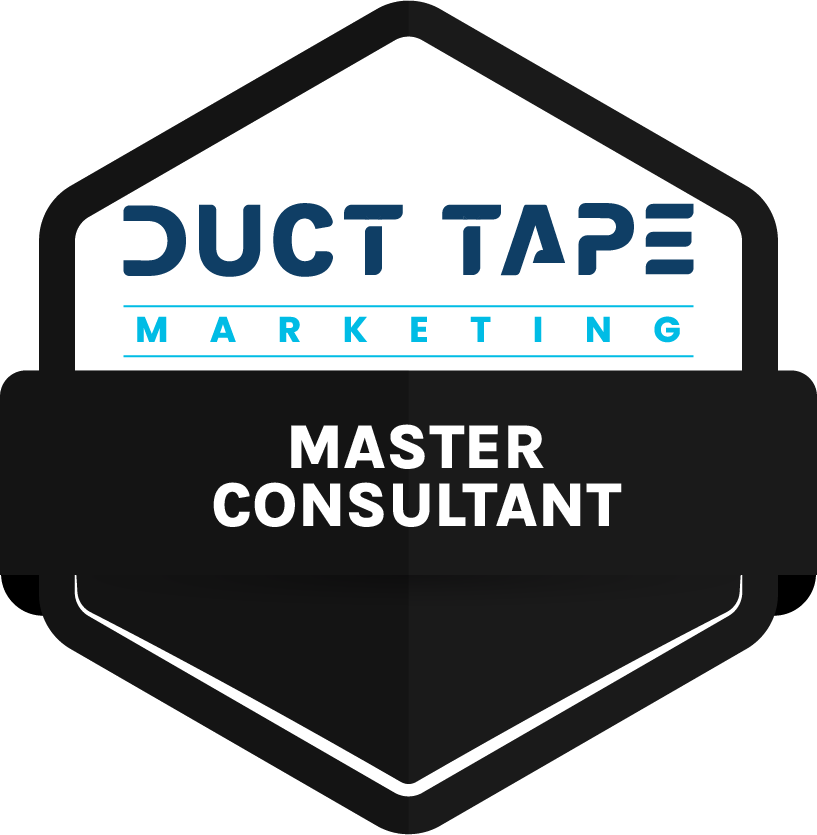Google Ads for House Cleaning Businesses: 5 Tips for Maximum ROI

In today's competitive market, house cleaning companies need to understand and use every tool at their disposal to attract new clients and grow their business. One of the most effective ways to achieve this is through Google Ads. This powerful advertising platform enables cleaning businesses to reach potential customers who are actively searching for their services, resulting in highly targeted leads and increased sales.
Let’s take a moment to be very clear on which Google Ads we’re talking about in this post. There are 2 main ad platforms from Google that house cleaning businesses can use. Google Local Service Ads and traditional Google Ads.
In this article we are talking about traditional Google Ads, where you can drive traffic to a landing page on your website. Google Ads provide a more branded experience than Google Local Service Ads (LSA) where traffic isn’t driven to your website. Traditional Google Ads are a powerful tool to drive awareness, traffic and conversions as well as gain long term ROI through direct traffic to your website.
We find that for house cleaning businesses, Google Ads and Google Local Service Ads will convert at nearly the same cost and conversion rate.
Leads from both platforms commonly convert into high paying long term clients for house cleaning businesses.
With this in mind, our view is that the smartest option is to leverage both platforms to avoid risk and weave them together into a diversified growth strategy that balances lead generation, security and brand awareness for your business.
Let’s Dive Into Google Ads

Google Ads is an essential component of any house cleaning company's digital marketing strategy, but it can be challenging to navigate its complexities and maximize your return on investment (ROI). That's where this article comes in. We've compiled a list of five actionable tips we’ve learned that will help cleaning companies like yours optimize their Google Ads campaigns, attract more clients, and ultimately, boost their bottom line.
In the following sections, we'll dive deep into each tip, providing you with the knowledge and insights you need to make the most of your Google Ads budget. By implementing these strategies, you can achieve the maximum ROI for your cleaning business and enjoy a steady stream of new customers. So, let's get started!
Tip #1: Target the Right Keywords

One of the most critical aspects of a successful Google Ads campaign is targeting the right keywords. By carefully selecting the keywords that best represent your cleaning services, you can ensure that your ads reach potential customers who are actively searching for what you offer. In this section, we'll discuss the importance of keyword research and selection for cleaning businesses and provide tips on choosing relevant, high conversion, low cost keywords.
a. Keyword Research and Selection for House Cleaning Businesses
Before you start creating your Google Ads campaign, it's essential to conduct thorough keyword research. This process involves identifying the words and phrases that your target audience is likely to use when searching for house cleaning services. By targeting these keywords, you can make sure your ads appear in front of the right potential customers at the precise moment they're looking for your services.
There are several tools available to help you with keyword research, such as Google's Keyword Planner, which provides valuable insights into search volume and competition for various keywords. To get started, make a list of general terms related to your house cleaning business, such as "house cleaning" and “maid service”, then use a keyword research tool to identify related keywords that potential customers might use in your area.
b. Choosing Relevant and Specific Keywords
When selecting keywords for your Google Ads campaign, focus on those that are both relevant and specific to your house cleaning business. Generic keywords, like "cleaning" or "cleaners," may have high search volumes but are also far less likely to drive a purchase, driving up your cost per click (CPC). Instead, choose more specific keywords with buying intent that describe your services more precisely. Examples might include "house cleaning service," "move out cleaning service," and "airbnb cleaning service.”. Each city across the country will perform a little different from keyword to keyword, so it’s important to try things and cover the bases until the data tells you what converts the best for you, and for the least amount of money.
Additionally, consider using location-based keywords to target customers in specific areas, such as "cleaning services in [city]" or "house cleaning in [neighborhood]." This approach can help you attract local customers who are more likely to convert. This approach will be more work to set up each specific geo-targeted campaign, but will reduce costs over the long haul.
c. Grouping Keywords Effectively to Maximize Ad Relevance and Quality Score
Once you've identified a list of relevant and specific keywords, it's crucial to group them effectively in your Google Ads campaign. Proper keyword grouping ensures that your ads are relevant to each keyword, leading to a higher Quality Score. A higher Quality Score can result in better ad placement, lower CPC (cost per click), and improved ROI.
To group your keywords effectively, divide them into tightly themed ad groups based on similar keywords and services. For example, you might create separate ad groups for house cleaning, office cleaning, and airbnb cleaning as well as others. Then, within each ad group, include a mix of closely related keywords. This approach allows you to tailor your ad copy and landing pages to the specific needs of each target audience segment, increasing ad relevance and improving overall campaign performance.
Targeting the right keywords is crucial for the success of your Google Ads campaign. Conduct thorough keyword research, choose relevant and specific keywords, and group them effectively to maximize ad relevance and your Quality Score. By doing so, you'll be well on your way to maximizing ROI for your house cleaning business.
Tip #2: Create Compelling Ad Copy

Once you have targeted the right keywords and organized them into tightly themed ad groups, the next step is to create compelling ad copy that entices potential customers to click on your ads. In this section, we'll discuss the role of ad copy in attracting clicks, share tips on crafting compelling headlines and descriptions, and emphasize the importance of highlighting the unique selling points and benefits of your cleaning services.
a. The Role of Ad Copy in Attracting Potential Customers
Your ad copy is the first impression potential customers have of your cleaning business, and it plays a crucial role in determining whether they click on your ad or not. Well-crafted ad copy can effectively communicate the value of your services, engage users, and persuade them to take action. On the other hand, poorly written ad copy can deter users from clicking on your ad, wasting your ad budget and reducing your ROI.
b. Tips for Crafting Compelling Headlines and Descriptions
To create ad copy that captures attention and encourages clicks, follow these best practices for crafting headlines and descriptions:
- Use your targeted keywords: Incorporate the primary keyword from your ad group into the headline and description. This helps reinforce the relevance of your ad to the user's search query and can improve your ad's visibility and click-through rate (CTR)
- Focus on benefits, not features: Instead of simply listing your cleaning services, emphasize the benefits your customers will enjoy. For example, instead of saying "professional house cleaning", say "create a more relaxing and happier home with our professional house cleaning services."
- Be clear and concise: Your ad copy should be easy to read and understand. Avoid jargon and complex language, and keep your headlines and descriptions short and to the point.
- Use a strong call-to-action (CTA): Encourage users to take action by including a CTA in your ad copy. Examples of effective CTAs for cleaning businesses include "Schedule a free estimate", "Book now", "Get a quote" or “Claim offer” if you have something special to offer new customers.
- Test multiple ad variations: Create multiple variations of your ad copy to see which headlines and descriptions perform best. Continually refine your ad copy based on performance data to optimize your CTR and conversion rate.
- Use emotional triggers to connect with potential customers and make your ad copy more impactful. For example, you could use phrases like "imagine coming home to a spotless, organized house" to tap into the desire for a clean and comfortable living space.
- Tailor your ad copy to different stages of the customer journey. For example, use more informational ad copy for users in the research phase, and more persuasive ad copy for users closer to making a purchase decision.
- Use ad extensions to provide additional information and make your ads more Compelling. For example, include a callout extension that highlights a special offer or promotion.
- Consider using dynamic keyword insertion to automatically insert the user's search query into your ad copy, which can make your ad more relevant and eye-catching.
c. Highlighting Unique Selling Points and Benefits
To set your house cleaning business apart from the competition, it's essential to highlight your unique selling points and the benefits your services offer. Consider what makes your cleaning services different from others in the market and focus on those aspects in your ad copy. For example, you might emphasize your organic cleaning products, a unique guarantee, your top ratings, or the fact your entire team has passed an extensive background check. By showcasing your unique value proposition, you can make your ads more appealing and persuasive to your best potential customers.
Creating compelling ad copy is essential for attracting potential customers to click on your ads and engage with your cleaning business. Follow the tips provided in this section to craft effective headlines and descriptions, and always remember to highlight your unique selling points and benefits. By doing so, you can optimize your ad performance and maximize your ROI
Tip #3: Design an Effective Landing Page

a. Explanation of Landing Pages and Their Importance in Converting Clicks to Leads/Sales
A landing page is the web page that users arrive at after clicking on your Google Ads. It plays a crucial role in converting clicks into leads or sales, as it is the primary point of interaction between your potential customers and your cleaning business. An effective landing page can significantly improve your conversion rate, helping you maximize the ROI of your Google Ads campaign. On the other hand, a poor landing page or website can literally block all conversions and could possibly waste your entire ad budget.
Not trying to use scare tactics here, but it’s 100% true. We’ve seen many many well meaning folks try ads by running traffic to a website that they “loved” but nobody else did and literally zero worthwhile leads came through the ads.
So then they decide “ads don’t work” and don’t try again for a decade! The point is, when it comes to Google ads, it’s not just who’s running the ads, but it’s also who’s running the page the ads are driving traffic to.
b. Tips for Designing an Effective Landing Page that Aligns with the Ad's Message and Offer
To design an effective landing page that drives conversions, consider the following tips:
- Maintain message consistency: Your landing page should closely align with the ad's message and offer. If your ad promises a specific service or promotion, ensure the landing page delivers on that promise. Consistency between your ads and landing pages will create a seamless user experience, increasing the likelihood of conversions.
- Use clear and concise headlines: Your landing page headline should clearly communicate your value proposition and be easy to understand. Make sure it aligns with the ad copy that brought users to the page and reinforces the benefits of your cleaning services.
- Showcase your unique selling points: Like your ad copy, your landing page should emphasize the unique selling points and benefits of your cleaning services. Use clear, compelling language and visuals to demonstrate what sets your business apart from the competition.
- Utilize engaging visuals: Authentic images and videos of you and your team can help convey the professionalism and quality of your cleaning services. Consider featuring photos of your team in action, before-and-after photos, customer testimonials, or a video showcasing your cleaning process.
c. Importance of Minimizing Distractions and Including Clear Calls-to-Action
A cluttered or confusing landing page can deter potential customers from converting. To maximize your conversion rate, minimize distractions on your landing page by eliminating unnecessary elements and focusing on a single, clear goal. Keep navigation and links to other parts of your website to a minimum, as they can distract users from the primary objective.
Additionally, make sure your calls-to-action are highly visible and easy to find. Position them prominently on the page, and consider using contrasting colors to make them stand out. By reducing distractions and providing clear CTAs, you can guide users towards taking the desired action, ultimately increasing your conversion rate and ROI.
Make it EASY for your prospects to engage with you how they want when they want with as little friction as possible. Provide your phone number, and answer it when they call, provide a link to request a quote or estimate through a simple form, provide a website chat feature to engage directly, and consider providing a complete self service estimate request form for technically savvy users. It’s not about being cute here, it’s more about developing trust and providing simple functionality as fast as possible, and less about how pretty the flower is in your background image. This is about making sales, growing effectively and providing a great service to your prospects and clients.
Designing an effective landing page is crucial for turning clicks into leads or sales. Align your landing page with your ad's message, emphasize your unique selling points, and minimize distractions to create a seamless user experience that drives conversions. By doing so, you can maximize the ROI of your Google Ads campaign and grow your cleaning business.
Tip #4: Optimize Bids and Budgets

a. Explanation of Bid Strategies and Budget Optimization for Google Ads
Managing bids and budgets effectively is essential for achieving maximum ROI from your Google Ads campaigns. Bid strategies determine how much you're willing to pay for each click on your ads, while your budget sets the overall amount you're willing to spend on your campaigns. Google Ads offers several bid strategies, each with different goals, such as maximizing clicks, conversions, or return on ad spend. Understanding and choosing the right bid strategy for your cleaning business is key to optimizing your ad performance and controlling costs.
b. Tips on Adjusting Bids and Budgets Based on Performance Metrics
To optimize your bids and budgets effectively, consider these tips:
- Monitor performance metrics: Regularly review your Google Ads performance metrics, such as click-through rate (CTR), cost-per-click (CPC), cost-per-conversion, and return on ad spend (ROAS). These metrics can help you identify areas for improvement and inform your bidding and budgeting decisions.
- Adjust bids based on keyword performance: Increase bids for high-performing keywords that drive valuable traffic and conversions, and decrease bids for keywords that underperform or generate low-quality traffic. This approach helps you allocate your budget more effectively and improve your overall campaign performance.
- Use ad scheduling: If your cleaning business receives more leads and conversions during specific times or days, consider using ad scheduling to adjust your bids accordingly. This can help you maximize your ROI by focusing your ad spend on the most profitable periods.
- Experiment with different bid strategies: Test various bid strategies to determine which one works best for your cleaning business. For example, if your primary goal is to maximize conversions, you might try a Target CPA (cost per acquisition) strategy. If your goal is to maximize clicks within your budget, you could try a Maximize Clicks strategy.
- Set realistic budgets: Ensure your budget is sufficient to achieve your campaign goals. If your budget is too low, your ads may not receive enough impressions or clicks to drive meaningful results. On the other hand, setting your budget too high can lead to overspending without a proportional increase in conversions.
c. Importance of Testing Different Bid Strategies and Budget Allocations to Achieve Maximum ROI
Constantly testing and refining your bid strategies and budget allocations is crucial for achieving the best possible ROI from your Google Ads campaigns. By monitoring performance metrics and making data-driven adjustments, you can identify the most effective bidding and budgeting strategies for your house cleaning business.
Optimizing your bids and budgets is a key factor in maximizing your Google Ads campaign's ROI. Regularly monitoring performance metrics, adjusting bids based on keyword performance, and testing different bid strategies and budget allocations can help you allocate your ad spend effectively and achieve the best possible results when running ads for your house cleaning business.
Tip #5: Monitor and Measure Performance

a. The Importance of Tracking and Analyzing Ad Performance Using Google Analytics
Monitoring and measuring the performance of your Google Ads campaigns is essential for optimizing your ROI and making informed decisions about your ad strategy. Google Analytics is a powerful tool that can help you track and analyze various performance metrics, such as user behavior, conversions, and ad effectiveness. By integrating Google Analytics with your Google Ads account, you can gain valuable insights into how users interact with your ads and landing pages, enabling you to identify areas for improvement and make data-driven adjustments to your campaigns.
b. Tips on Setting Up Conversion Tracking and Monitoring Relevant Metrics
To effectively monitor and measure your Google Ads performance, follow these tips:
- Set up conversion tracking: Conversion tracking enables you to track specific actions users take after clicking on your ads, such as filling out a contact form or booking a cleaning service. To set up conversion tracking, create conversion actions in your Google Ads account and add the corresponding tracking code to your website or landing pages.
- Link Google Ads and Google Analytics: Connecting your Google Ads and Google Analytics accounts allows you to access detailed information about user behavior, such as bounce rate, time on site, and pages per session. This data can help you identify areas for improvement and optimize your ad campaigns for better performance.
- Monitor relevant metrics: Focus on the metrics that matter most to your cleaning business, such as click-through rate (CTR), cost-per-click (CPC), cost-per-conversion, and return on ad spend (ROAS). Regularly reviewing these metrics can help you identify trends and make informed decisions about your bidding, budgeting, and ad strategy.
- Use Google Ads reports: Google Ads offers various reports that can help you analyze your campaign performance, such as the Search Terms report, Auction Insights report, and Performance by Ad Group report. Use these reports to identify high-performing keywords, assess your competition, and uncover opportunities for improvement.
c. Importance of Ongoing Optimization and Making Data-Driven Decisions to Improve Ad Performance
Achieving the best possible ROI from your Google Ads campaigns requires continuous optimization and data-driven decision-making. By regularly monitoring your performance metrics, setting up conversion tracking, and leveraging Google Analytics data, you can identify areas for improvement and make informed adjustments to your ad strategy.
As you optimize your campaigns, be prepared to make changes based on your findings. This may involve refining your keyword targeting, adjusting your bids and budgets, improving your ad copy and landing pages, or testing new ad formats and targeting options. By continually analyzing your performance data and making data-driven decisions, you can improve your ad performance and maximize the ROI of your Google Ads campaigns.
Monitoring and measuring your Google Ads performance is essential for optimizing your campaigns and achieving maximum ROI. Set up conversion tracking, link Google Ads and Google Analytics, and focus on the metrics that matter most to your cleaning business. By making ongoing, data-driven optimizations, you can improve your ad performance and drive growth for your house cleaning company.
Summary

In this article, we've discussed five essential tips for maximizing the ROI on Google Ads for cleaning businesses. To recap, these tips include:
- Targeting the right keywords: Conduct thorough keyword research and select relevant, specific keywords with low competition. Group your keywords effectively to improve ad relevance and quality score.
- Creating compelling ad copy: Craft attention-grabbing headlines and descriptions that highlight the unique selling points and benefits of your cleaning services to encourage potential customers to click on your ads.
- Designing an effective landing page: Ensure your landing page aligns with your ad's message and offer, minimizes distractions, and includes clear calls-to-action to improve conversion rates.
- Optimizing bids and budgets: Adjust your bids and budgets based on performance metrics, experiment with different bid strategies, and allocate your ad spend effectively to maximize ROI.
- Monitoring and measuring performance: Track and analyze your ad performance using Google Analytics, set up conversion tracking, and make data-driven decisions to optimize your campaigns continuously.
Google Ads is a powerful platform that can drive significant growth for cleaning companies when used effectively. By implementing these five tips, you can optimize your ad campaigns and make the most of your advertising budget, ultimately achieving maximum ROI and driving new leads and sales for your cleaning business. As you embark on your Google Ads journey, remember that ongoing optimization and data-driven decision-making are critical to your success. Keep refining your strategies and leveraging the insights provided by Google Analytics and Google Ads reports to ensure your campaigns continue to deliver exceptional results.

About the Author: As founder of CleaningMarketing.com, Justin is a house cleaning growth consultant and digital marketing expert with over 17 years of experience. He’s helped sell over $100M in local services and has worked with house cleaning and commercial cleaning businesses over the past decade.










